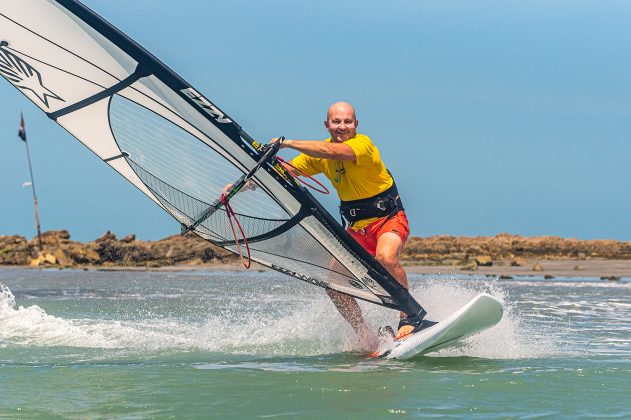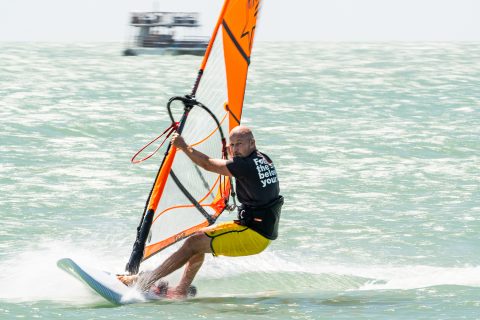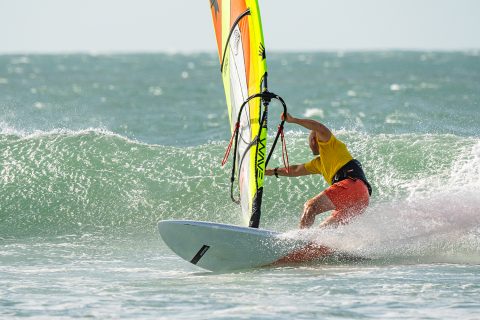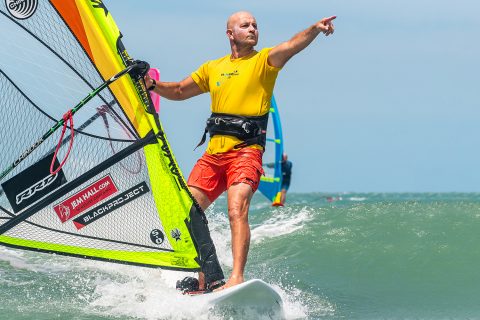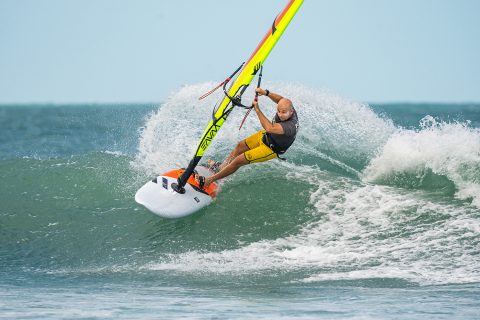JEM HALL
MOVE ON UP
LITTLE WINS
JEM HALL: LITTLE WINS
PHOTOS – Eye Sea You Photo
Jem Hall gives some awesome tips for making the most of side-shore and small wave conditions.
This month I look at how to get the very best out of sailing a side-shore / small wave location. Examples of this might be Jeri, Brazil or from my UK days, Hayling Island on the south coast of England. I will highlight the skills and moves to work on in order to keep you progressing, challenged and busy.
Essential skills
In order to be in the best position to enjoy and improve in the waves, be they big or small, then the skills listed below should be honed and refined. This is often best done on flat water, or easier conditions, so you have more chance to improve. Many of my wave clients come on flat water coaching clinics in order to be ready to rip in the waves.
Early planing – as ever this is a HUGE skill. Nail this and you will get up to speed earlier, and faster, and then you can not only get more jumps, but the other bonus is you can get upwind quicker, so you have the position to then catch and ride more waves.
Getting upwind – so important in the waves. This needs to be conquered both non-planing and medium planing. The better you are at this the more jumps, moves and rides you will get.
Sailing fast off the wind – this will get you to a suitable peak faster in order to jump, or to a nice section of a wave to ride.
Jumps both ways – get into jumps on the flat so you are used to getting over the board and really getting the board higher off of small chop. Do this both ways so you can enjoy the wind from both directions, and also so you can learn to aerial on the wave.
Tacks – these keep you upwind so you can do more moves. It will also put you in a better position on a wave and perhaps earn you the priority on a wave from being first on it, or furthest upwind.
Slower transitions – you will not always be planing, so it is advantageous to be able to tack or gybe non-planing in order to get onto a wave on your way out. Or turn around on the inside before you lose the wind. I use the heli-tack a lot in waves, as it is easier for me when going slow.
Into the straps non-planing – in waves you have not got the time, or space, to plane and then get in the straps, so you need this skill. I introduce and coach this a lot on my flat-water clinics.
Strategy
Absorb or jump – getting out is about conservation of momentum. Each wave you meet wants to push you backwards, so getting past each one is about doing it in a way that minimises your loss of speed, so that by the time you meet the ramp you have enough speed to launch to the moon.
Read ahead – scan ahead for waves to jump or tack onto for riding. When it is small you must take every opportunity you have.
Go early – people can get caught out waiting for bigger ramps out the back and then they do not appear and so they miss out. Mix it up and go hard on the first ok ramp that comes, but also then send it on the bigger ones.
Be ready – to tack onto a wave. Sometimes people want to get settled and then get out the back and turn round. However, if a nice wave comes, get on it and ride it.
Wait – time and again I have seen people get on a wave and go too early along it, when it is still too small. Wait high on the wave and then go if it is good.
Use the wave to get upwind – waiting on the wave before you start to ride it means you can also use it to get upwind on. However, after you have done your wave ride you can gain a lot of ground by going upwind on the whitewater, out of the straps.
No ripple riding – riding small waves makes you ride bad as the rig stays loaded and the wave gives you no energy.
Keep it simple – exaggerate your key actions of head, hips and hands. These might be looking forward into the bottom turn, then up to the lip and then out of the top turn. Or focusing on back hand right back in the bottom turn and then all the way forward in your top turn.
Don’t milk it – the more turns you make, the further along the wave you are and this typically means the wave is smaller and has less power. It also means you have further to go to get back upwind to catch the next wave. And, in Jeri as an example, this means that you are more likely to be in the wind shadow so your transition is hard, and if you fail, it makes the waterstart even harder. I often tell my students, ‘2 turns only!’
Too far out – heading out to sea too far will mean you have less chances to jump and ride, so don’t do it!
Mix it up – if you have some sets (of waves) coming in, albeit small, I find it best to mix it up between jumping or riding these sets. When it is bigger the priority often goes to riding the sets.
Get home, eventually – if you get a really nice wave to ride, then don’t worry about working more turns on it, and ending up downwind, as you can take a longer run out to sea and then on the way in use a wave to get upwind.
Exit plan – after you have completed a wave ride, choose between gybing off it, planing in front of it and tacking, or letting the small whitewater go underneath you and then turning around. Do this and don’t just jump off your board in shallower water and turn you gear around, this is lazy and unfocussed.
Moves to work on
There might not always be a wave to jump or ride so you should keep busy by trying other stuff. If the waves are a bit small then challenge yourself with some of the moves I suggest. I call this ‘squeezing’ the very best out of any conditions and I do it in every session.
- Get your tail up and front hand in on those jumps.
Transitions
In small waves, with less pressure on you, it can be fun to practice these moves, and they will also challenge and improve your sailing.
Gybe / tack onto wave – while this requires good execution and consistency, to make the move it also requires you to come out of it efficiently and then get in the straps as early as possible. Then you can stay on the wave and / or go straight into a wave ride.
- Tacking is king, this keeps you more upwind to get more jumps and rides.
Duck gybes – this is so fun, and who hasn’t loved seeing Mr Goya or Naish do this. Spot your wave and duck gybe onto it and get out of it before the wave passes you by!
Rides
- Keep it simple, hand back in the bottom turn and see the lip to open the sail and get up the wave.
There are many different turns you can make on a wave. The moves below are great to try in smaller waves. A lot of these moves are covered in my wave articles you can view on this magazine’s website – windsurf.co.uk.
Late hit – improving your timing of when to ‘go’ on a wave will really develop your wave sailing. Going ‘late’, (when the wave is about to break), is less scary in smaller waves and will see you not only progress, but also develop the required risk taking mindset you need to be a good wave sailor. My main tip is to get the bottom of the board at the wave so it hits it and pushes you out of the turn with energy.
- Look out of your top turn and slide that back hand up the boom, as you shift your hips outboard.
One-handed top turn – this feels great and after sliding your back hand up the boom to perform your top turn you are in a great position to release your front hand. And if you are not well placed then doing this move will really improve both your hand and body position to achieve this.
- Get and keep upwind in the waves by going upwind, out of the straps, along the wave.
Aerial – sometimes a wave has no section or wall to work with so your turns will be bad. Yet a little section might be building up so then you can go along the wave and do a little half turn and a hop and get an aerial. If you fall, no worries because you are in small waves.
Jumps
Again please do revisit some of my old articles for a refresh on these moves.
- Small side-shore waves are perfect for looping, so get that back hand back, look behind you and pull those triggers.
Tail up jumps – these are so important in waves! Doing these will give you safer and faster landings so you can do more jumps in every session. They will also help you progress onto the moves below.
Tail grab jumps – this is a fun move, and a real skill developer. It will make you lean back, pull in on your front hand and really pull up on your back leg. And once you get to that tail you know you are doing it right.
Loops – small waves with side-shore winds are the absolute best conditions to learn to loop in. It means you can go at the wave off the wind and make a nice rotation and also you will be less scared because the wave will not throw you too high in the air. These conditions give you a chance for doing plenty of repetitions too, and this helps people learn to loop quicker. These conditions will also help you get your loops cleaner and faster, and maybe even higher.
Send and float – small waves can help you learn to boost some air. Many people just flop off the wave to get a jump and are not active enough. If you get good speed out and do a really active ‘pop’ off a small wave then you can boost some height and then improve your ability to float down by getting the board off the wind, and the rig over your head.
- Carve off your heels to send some spray. It can be best from here to cutback., get high on the wave so you can see if you can turn again. Don’t milk it!
Kit:
Generous straps to allow feet to get in and out of the footstraps smoothly. This stabilises the board and it is also safer as you can eject when required, it will also help you get your toes down for riding and jumping.
Long lines enable unhooking from a low position and help with one-handed jumps.
Faster, slightly bigger boards are more fun in smaller waves as you can get more air with them and keep more speed on the wave.
Changing up or down fins can really help you get more range out of your gear, for example, in a thruster set-up I use a 21.5 cm back fin when underpowered on a 5.5 sail, and a 18.5 cm for well powered on a 5.0 sail.
Ezzy sails, RRD (boards, wetsuits & softwear), Chinook & Black Project fins sponsor Jem Hall. Get him live and direct on one of his highly acclaimed coaching holidays – check out his website www.jemhall.com for details. You can also follow him on twitter / Facebook / Instagram.

